- Sorry, this product is unavailable.
-

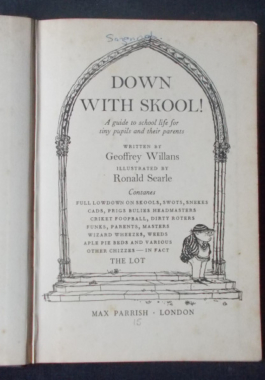 Meet Nigel Molesworth and his 'grate frend' Peason, veteran pupils at St. Kustards School for Boys. Between them they cover all aspects of boarding school life: Masters At a Glance, Kanes I Have Known; Skool Prospectus; How to Torture Parents and other survival skills. This volume 'contanes the full lowdown on skools, swots, sneeks, cads, prigs, bulies, headmasters, criket, foopball, dirty roters, funks, parents, masters, wizard wheezes, weeds, aple pie beds and various other chizzes...' (That's Nigel's and Pearson's spelling, by the way - not mine...) Written specifically as a 'guide to school life for tiny pupils and their parents' From the creators of St. Trinians and with hilarious illustrations by Ronald Searle.
Meet Nigel Molesworth and his 'grate frend' Peason, veteran pupils at St. Kustards School for Boys. Between them they cover all aspects of boarding school life: Masters At a Glance, Kanes I Have Known; Skool Prospectus; How to Torture Parents and other survival skills. This volume 'contanes the full lowdown on skools, swots, sneeks, cads, prigs, bulies, headmasters, criket, foopball, dirty roters, funks, parents, masters, wizard wheezes, weeds, aple pie beds and various other chizzes...' (That's Nigel's and Pearson's spelling, by the way - not mine...) Written specifically as a 'guide to school life for tiny pupils and their parents' From the creators of St. Trinians and with hilarious illustrations by Ronald Searle. -

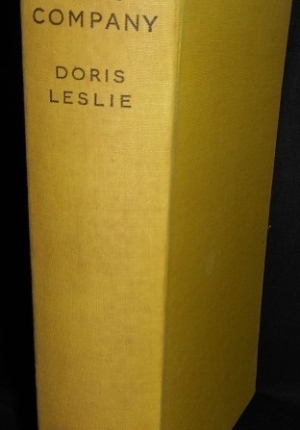
Doris Leslie: Fair Company
$15.00This novel spans 130 years and follows the line of women of the Wrotham family, beginning with Sabrina in 1806. The daughter of a socially disgraced, sadistic roué, she is sponsored into 'Society' by her step-aunt - after having had some good manners vigorously instilled in her and her tomboyish ways smoothed out. Her brother Prior's marriage and production of children play a part in keeping the Wrotham name going. The next Wrotham woman is Clare - her brother Anthony's marriage to Harriet brings Charlotte to the line and the last is Gillian Rose, known as 'Jill'. The diaries and letters of the women are fictitious but the times in which the story is set are not, and many historical characters and events of England are brought to the story. As the generations overlap, with the members of each generation subscribing to the beliefs of their day, there is little sentimental romance involved - just a very good story, tinted with gentle romance and enhanced by the backdrop of historic reality. -

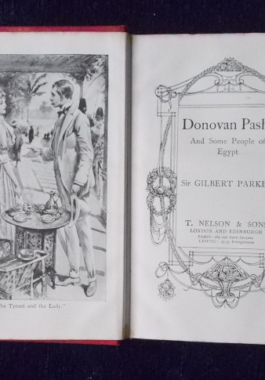
Said Sir Gilbert Parker: 'Who the original of ‘Donovan Pasha’ was I shall never say, but he was real. There is, however, in the House of Commons today a young and active politician once in the Egyptian service, and who bears a most striking resemblance to the purely imaginary portrait which Mr. Talbot Kelly, the artist, drew of the Dicky Donovan of the book. This young politician, with his experience in the diplomatic service, is in manner, disposition, capacity, and in his neat, fine, and alert physical frame, the very image of Dicky Donovan, as in my mind I perceived him; and when I first saw him I was almost thunderstruck, because he was to me Dicky Donovan come to life. There was nothing Dicky Donovan did or said or saw or heard which had not its counterpart in actual things in Egypt. The germ of most of the stories was got from things told me, or things that I saw, heard of, or experienced in Egypt itself. The first story of the book—‘While the Lamp Holds Out to Burn’—was suggested to me by an incident which I saw at a certain village on the Nile, which I will not name. Suffice it to say that the story in the main was true. Also the chief incident of the story, called ‘The Price of the Grindstone—and the Drum’, is true. The Mahommed Seti of that story was the servant of a friend of mine, and he did in life what I made him do in the tale. ‘On the Reef of Norman’s Woe’, which more than one journal singled out as showing what extraordinary work was being done in Egypt by a handful of British officials, had its origin in something told me by my friend Sir John Rogers, who at one time was at the head of the Sanitary Department of the Government of Egypt.'
-
 Obadiah and Elizabeth ‘flabbergasted frightfully’ when they heard their three children, Daniel, Walter and Sarah, were considering leaving England and joining the goldrush to the Antipodes - the Australian Goldfields. The children expected to find gold and to make ‘their everlasting fortune.’ Their parents could only see the terrible dangers involved in what they considered ‘a foolhardy adventure.’ Obadiah and Elizabeth concluded a warning letter they wrote to Walter, Daniel and Sarah with this desperate plea: PLEASE, PLEASE, DO NOT GO TO THE GOLDFIELDS. This is an entertaining look at life on the goldfields in the 1850s from the journey from 'Home' to the Antipodes; the scenes of drunkneness and brawling that greeted the shocked Britishers; the intriguing crimes of interfering with your own clock, severing a clothesline, kite flying and why they were deemed to be criminal; the women of the goldfields and what life was like for children and school students. For teenage readers and upwards. Illustrated by Carson Ellis.
Obadiah and Elizabeth ‘flabbergasted frightfully’ when they heard their three children, Daniel, Walter and Sarah, were considering leaving England and joining the goldrush to the Antipodes - the Australian Goldfields. The children expected to find gold and to make ‘their everlasting fortune.’ Their parents could only see the terrible dangers involved in what they considered ‘a foolhardy adventure.’ Obadiah and Elizabeth concluded a warning letter they wrote to Walter, Daniel and Sarah with this desperate plea: PLEASE, PLEASE, DO NOT GO TO THE GOLDFIELDS. This is an entertaining look at life on the goldfields in the 1850s from the journey from 'Home' to the Antipodes; the scenes of drunkneness and brawling that greeted the shocked Britishers; the intriguing crimes of interfering with your own clock, severing a clothesline, kite flying and why they were deemed to be criminal; the women of the goldfields and what life was like for children and school students. For teenage readers and upwards. Illustrated by Carson Ellis. -
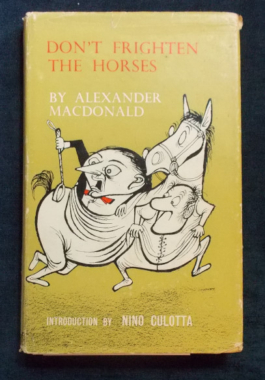 The title of this novelty item is from a saying of King Edward VII: "I don't care what the people do, as long as they don't do it in the streets and frighten the horses." Macdonald was frequently compared to humourist Lennie Lower, although Macdonald's humour is more sophisticated. He also loved the comic-scope of 'the little bloke who gets pushed around'. Therefore, we see our hero being browbeaten by his bank manager, getting lost in the Paris underground, in Darlo Police Station and musing on such diverse topics as literature, travelling, eating and drinking. With an introduction by 'Nino Culotta'. Illustrated by Clarrie King. Very Australian humour.
The title of this novelty item is from a saying of King Edward VII: "I don't care what the people do, as long as they don't do it in the streets and frighten the horses." Macdonald was frequently compared to humourist Lennie Lower, although Macdonald's humour is more sophisticated. He also loved the comic-scope of 'the little bloke who gets pushed around'. Therefore, we see our hero being browbeaten by his bank manager, getting lost in the Paris underground, in Darlo Police Station and musing on such diverse topics as literature, travelling, eating and drinking. With an introduction by 'Nino Culotta'. Illustrated by Clarrie King. Very Australian humour. -
 An essential guide to Australian rhyming slang drawn from oral sources in and around Sydney. Three of the author's best informants were mates who'd spent some time as guests of Her Majesty in Sydney's Long Bay Jail. Two other prolific sources were a couple of retired shearers. Great as a social document or just for fun - or even as a gift to a 'New Australian' so they know the meaning of such phrases as He did a Harold Holt (bolted, vanished); Here comes the John Hops/Johns (cops, the police); I'm on me Pat Malone; I'm alone; The saucepan lids are home on holidays - The kids are home on holidays plus many more.
An essential guide to Australian rhyming slang drawn from oral sources in and around Sydney. Three of the author's best informants were mates who'd spent some time as guests of Her Majesty in Sydney's Long Bay Jail. Two other prolific sources were a couple of retired shearers. Great as a social document or just for fun - or even as a gift to a 'New Australian' so they know the meaning of such phrases as He did a Harold Holt (bolted, vanished); Here comes the John Hops/Johns (cops, the police); I'm on me Pat Malone; I'm alone; The saucepan lids are home on holidays - The kids are home on holidays plus many more. -
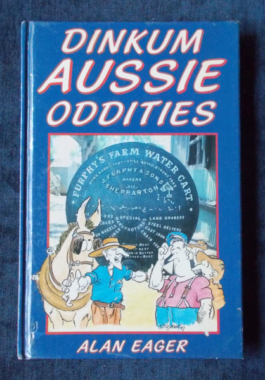 A guide book for those things that could only be found in Australia: Snake Gully's 'Dad and Dave' statues near Gundagai; the famous 'Dog on the Tuckerbox'; The Big Cod at Tocumwal and the Big Yabby at Wentworth; The Big Sapphire near Anakie and much more...and not forgetting the infamous 'Furphy.' This book is definite proof that Australians really are a 'weird mob'. Illustrated with cartoons and colour and black and white photographs.
A guide book for those things that could only be found in Australia: Snake Gully's 'Dad and Dave' statues near Gundagai; the famous 'Dog on the Tuckerbox'; The Big Cod at Tocumwal and the Big Yabby at Wentworth; The Big Sapphire near Anakie and much more...and not forgetting the infamous 'Furphy.' This book is definite proof that Australians really are a 'weird mob'. Illustrated with cartoons and colour and black and white photographs. -
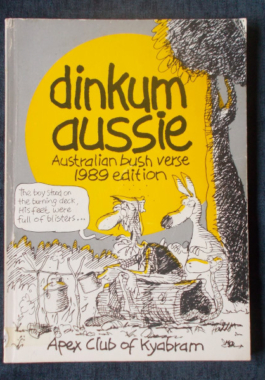 Includes such Aussie gems as: Picking Out the Melon Pips; The Bush Wedding; The Old Bark Hut; Ya' Stupid Galah!; Much Ado About a 'Roo; Anzac Day and many more unique true-blue poems. The Apex Club of Kyabram issued the first 'Dinkum Aussie Award' for Bush Verse in 1988 and were so pleased at the response, they went for it and 'had another go' in 1989. Who knows - some of the coves in here might be famous writers by now!
Includes such Aussie gems as: Picking Out the Melon Pips; The Bush Wedding; The Old Bark Hut; Ya' Stupid Galah!; Much Ado About a 'Roo; Anzac Day and many more unique true-blue poems. The Apex Club of Kyabram issued the first 'Dinkum Aussie Award' for Bush Verse in 1988 and were so pleased at the response, they went for it and 'had another go' in 1989. Who knows - some of the coves in here might be famous writers by now! -
 The trip with the football team is a tradition and a rite of passage: the first trip where they stay at motels rather than being billeted, someone's going to lose his virginity, everyone's expected to get drunk... On this trip The Sandman makes a significant discovery - which he can't disclose, because then it won't be his secret anymore. Sandy is a natural bus clown- not the leader of the group, but the one who entertains the others and performs his funny noises if the cool players at the back of the bus get bored, such as the Pterodactyl, the Lip Trumpet, Compressed Air Walking.... This will resonate with blokes who grew up in Australia - specifically Newcastle - in the early to mid seventies. Politically incorrect cover art by Michael Bell, The Sandman, Archibald Prize finalist 2000.
The trip with the football team is a tradition and a rite of passage: the first trip where they stay at motels rather than being billeted, someone's going to lose his virginity, everyone's expected to get drunk... On this trip The Sandman makes a significant discovery - which he can't disclose, because then it won't be his secret anymore. Sandy is a natural bus clown- not the leader of the group, but the one who entertains the others and performs his funny noises if the cool players at the back of the bus get bored, such as the Pterodactyl, the Lip Trumpet, Compressed Air Walking.... This will resonate with blokes who grew up in Australia - specifically Newcastle - in the early to mid seventies. Politically incorrect cover art by Michael Bell, The Sandman, Archibald Prize finalist 2000.


